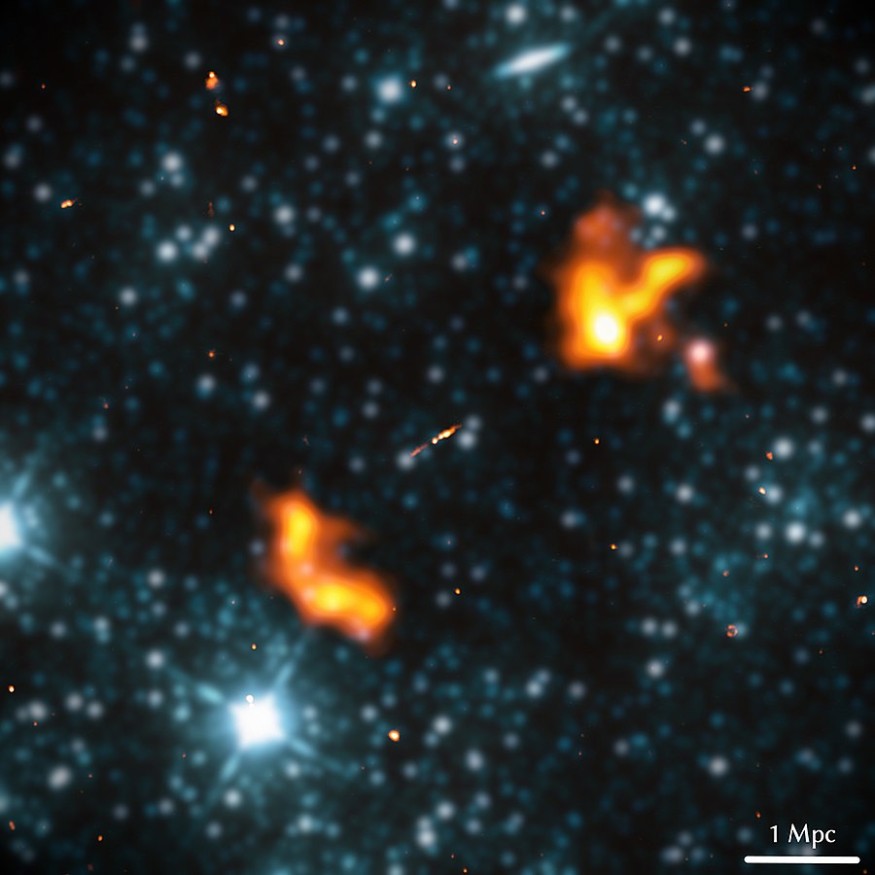Earlier this year, a team led by Ph.D. candidate Martijn Oei of Leiden Observatory in the Netherlands, discovered a radio galaxy from 3 billion light-years away that is at least 16 million light-years long. The press release reports that it constitutes the largest known structure of galactic origin and that the discovery disproves some long-held hypotheses about the radio of radio galaxies.
Most importantly, it highlights the poor understanding of these massive cosmic structures and what drives their growth. The finding could provide a better understanding of giant radio galaxies.

Supermassive Black Holes in Radio Galaxies
Radio galaxies are home to supermassive black holes, which release energy in the form of two radio jets from opposite sides of the galactic nucleus as matter falls into them. Giant radio galaxies are yet another massive mystery in a universe full of mysteries as they consist of a host galaxy and colossal jets and lobes that erupt from its center.
As per Science Alert, these jets and lobes are interacting with the intergalactic medium and act as a synchrotron to accelerate electrons and generate radio emissions. The supermassive black holes inside them are believed to have created the jets and astronomers refer to a black hole as "active" when it is accreting material from a giant disk around it.
But sometimes a small fraction of the material in the region of the accretion disk swirling into an active black hole gets funneled to the poles where it is blasted to enormous distances in space in the form of jets of ionized plasma at a speed almost similar to light before they spread out into giant radio-emitting lobes.
This process can be seen in other galaxies too, such as the Milky Way. However, scientists still don't know why this happens and why they absolutely grow in gargantuan sizes in some galaxies. These radio galaxies are extreme examples of cosmic objects that scientists could study to understand the universe.
Oei explained in the study, titled "The discovery of a radio galaxy of at least 5 Mpc" published in the journal Astronomy and Astrophysics, that the host of the largest giant radio galaxies is likely to possess characteristics suitable for giant radio galaxy growth. Similarly, the largest radio galaxies would have resided in them if large-scale environments were conducive to hosting giant radio galaxies.
How They Detected Alcyoneus Radio Galaxy
Astronomers named the biggest galaxy ever found Alcyoneus, a giant offspring of Gaia. They used data from the Low-Frequency Array (LOFAR) network of radio telescopes found across Europe to detect Alcyoneus, according to Space.com. Researchers saw two massive plasma plumes emitted from a supermassive black hole at the center of the galaxy.
These two plasma plumes stretch more than 100 Milky Ways in diameter, which now holds the largest known structure of galactic origin. The material these jet streams blast into space includes the building blocks for a star. As it travels almost at the speed of light, these plumes heat up and dissolve into plasma and glow in radio light that helped LOFAR detect them.
Astronomers were unable to detect the Alcyoneus before because the plumes were relatively faint. But as they reprocessed existing images, they found subtle patterns that alerted them to the massive galaxy.
RELATED ARTICLE: James Webb Space Telescope May Have Found the Oldest Galaxy Ever That Existed 13.5 Billion Years Ago
Check out more news and information on Space in Science Times.











